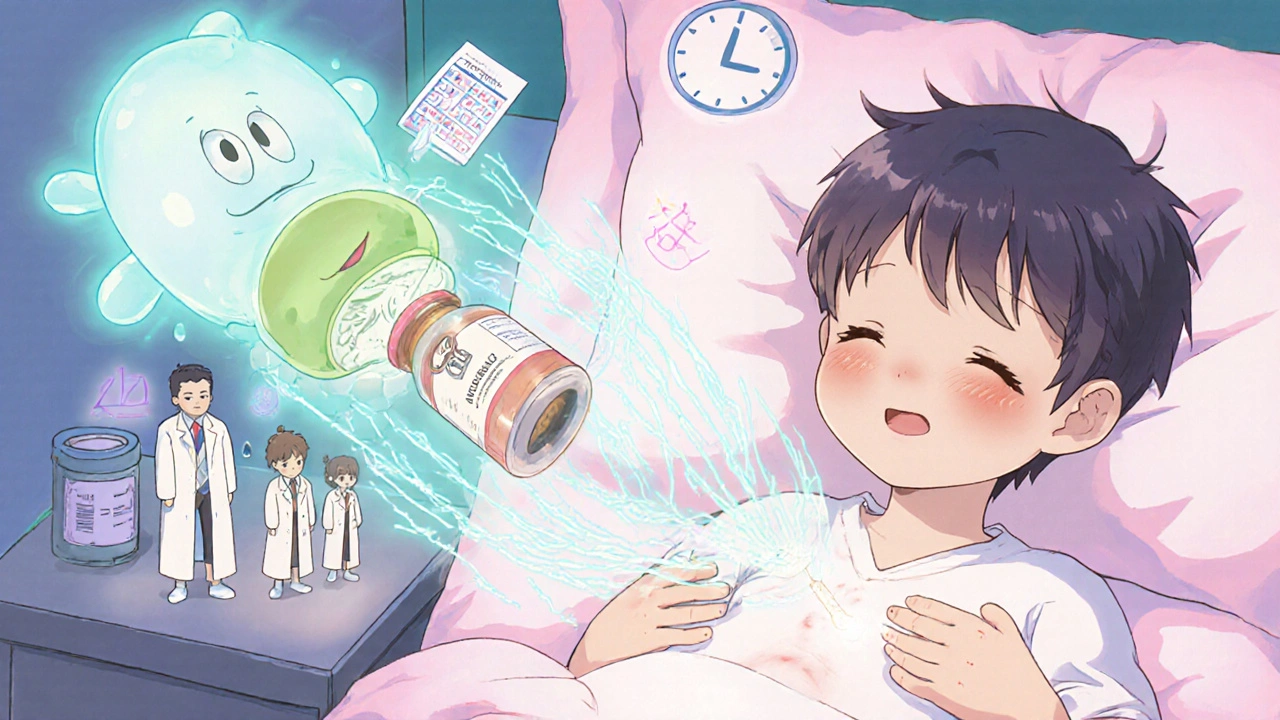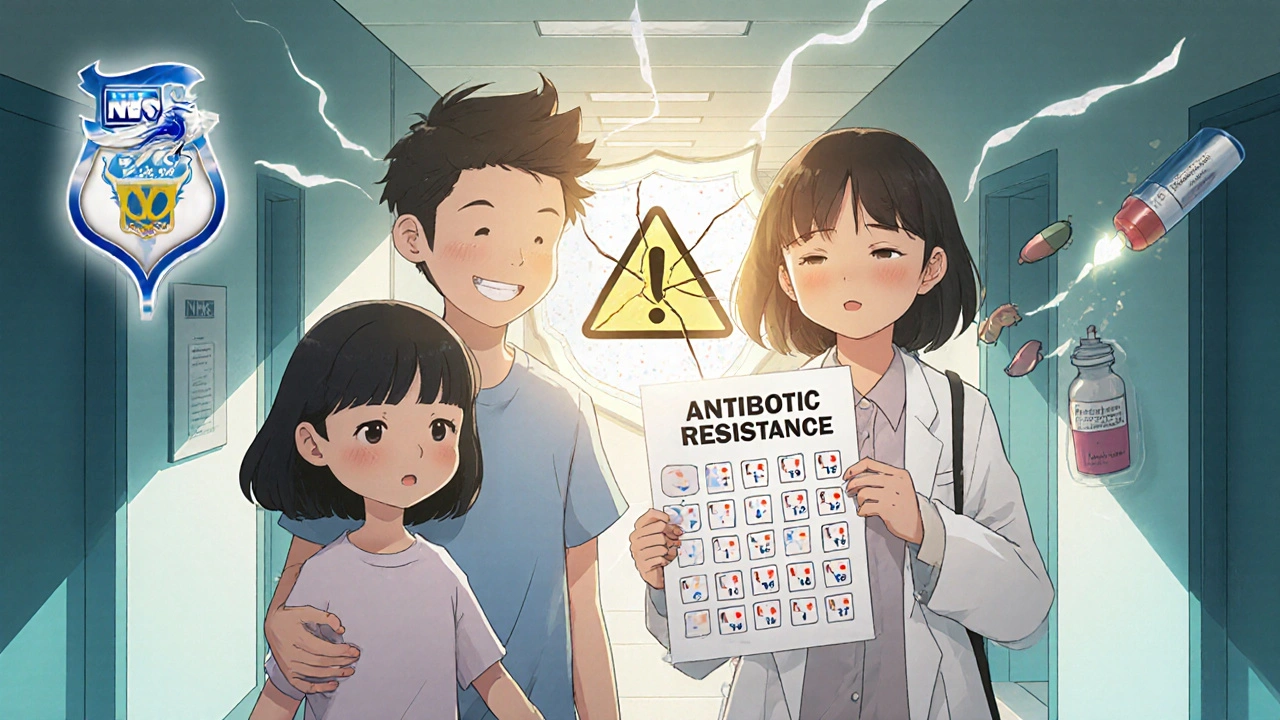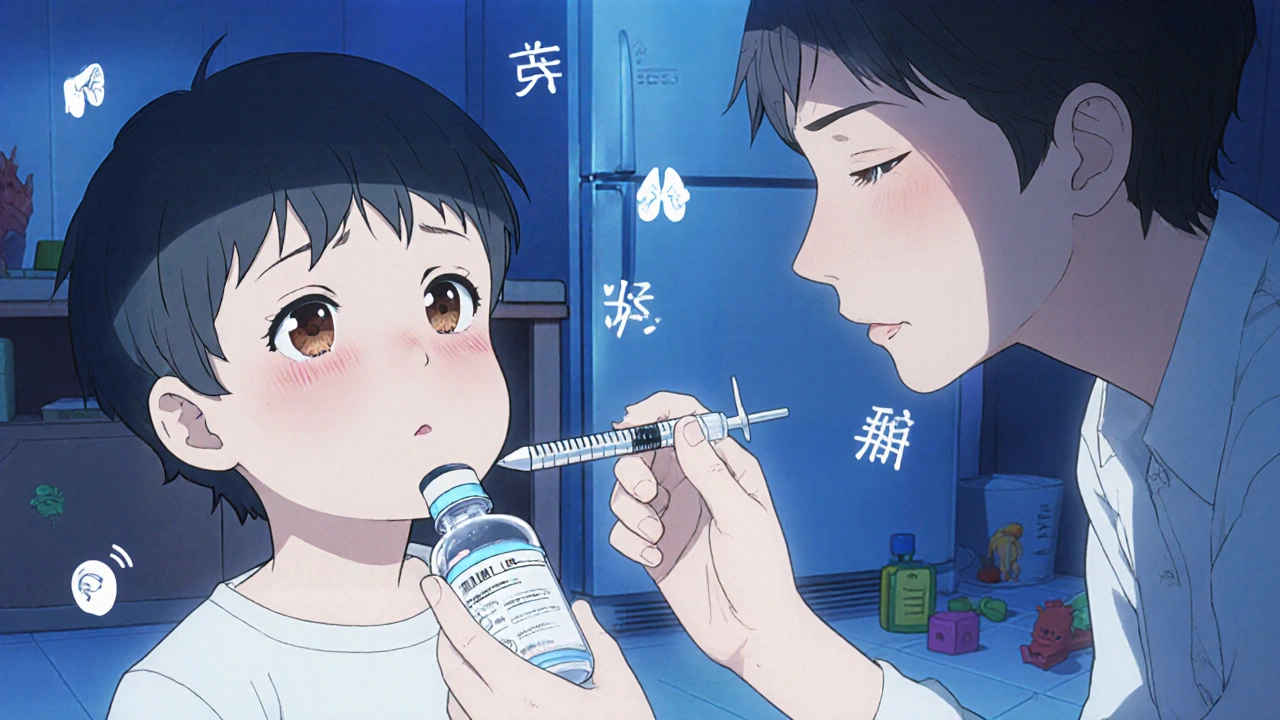When your child gets sick with a stubborn ear infection, strep throat, or pneumonia, your doctor might prescribe amoxicillin. It’s one of the most common antibiotics given to kids - and for good reason. But knowing amoxicillin is safe doesn’t mean you can guess the dose or ignore the warnings. Giving the wrong amount, skipping doses, or stopping too early can make things worse. Here’s what you actually need to know to use amoxicillin safely and effectively for your child.
What Is Amoxicillin and Why Do Doctors Prescribe It for Kids?
Amoxicillin is a penicillin-type antibiotic that kills bacteria causing infections like ear infections, sinus infections, pneumonia, strep throat, and urinary tract infections. It doesn’t work on viruses - so if your child has a cold or the flu, amoxicillin won’t help. That’s why doctors don’t hand it out like candy. They only prescribe it when tests or symptoms point to a bacterial infection.
It’s popular for children because it comes in liquid form, tastes better than older antibiotics, and is gentle on the stomach. The body absorbs it well, and it reaches the infection sites quickly. In the UK, amoxicillin is on the NHS list of essential medicines, meaning it’s proven, affordable, and widely used.
How Is the Dosage Calculated for Children?
Unlike adults, kids don’t get a fixed pill. Their dose is based on weight - not age. The standard dose for most infections is 20 to 45 mg per kilogram of body weight per day, split into two or three doses. For example:
- A 10 kg child might get 200-450 mg per day, given as 100-225 mg twice a day.
- A 20 kg child might get 400-900 mg per day, split into 200-450 mg twice a day.
Your doctor or pharmacist will calculate this exactly. Never guess. If your child gains or loses weight during treatment, let the doctor know. Some infections - like severe pneumonia or strep throat - may need higher doses, up to 80-90 mg/kg/day. That’s only done under medical supervision.
Always use the measuring syringe or cup that comes with the medicine. Kitchen spoons are not accurate. A teaspoon might hold 4-6 ml, but the dose might be 5.7 ml. That tiny difference adds up over several doses and can lead to under- or overdosing.
What Are the Common Side Effects?
Most children tolerate amoxicillin well. But side effects happen. The most common ones are:
- Diarrhoea - mild and temporary, but can be severe if it turns into C. diff infection.
- Nausea or vomiting - often goes away after a few doses or if given with food.
- Rash - especially in kids with mononucleosis (glandular fever). This isn’t always an allergy.
- Yeast infections - diaper rash or oral thrush in babies.
If your child gets a red, itchy, raised rash that spreads quickly, or has trouble breathing, swelling of the face or tongue, or wheezing - stop the medicine and call 999. These are signs of a serious allergic reaction.
Many parents mistake a viral rash for an amoxicillin allergy. If your child had a rash after taking amoxicillin before, don’t assume it’s an allergy. Ask your GP to check. Many kids outgrow it, or it was never an allergy at all.
How Long Should You Give It?
Even if your child starts feeling better after two days, finish the full course. Stopping early lets the strongest bacteria survive. They multiply and come back - stronger. This is how antibiotic resistance starts.
Most courses last 5 to 10 days, depending on the infection. Ear infections in younger kids often need 10 days. Strep throat can be treated in 5-7 days. Always follow what’s written on the label. If you’re unsure, call the pharmacy. Don’t rely on memory.

Tips for Giving Amoxicillin to a Reluctant Child
Many kids hate the taste. Here’s what actually works:
- Chill the liquid before giving it. Cold numbs the taste buds slightly.
- Give it with a spoon or syringe, not a bottle. It helps control the dose and prevents spills.
- Follow it with a small sip of juice or water. Avoid dairy right after - it can bind to the antibiotic and reduce absorption.
- Try mixing it with a small amount of applesauce, yogurt, or jam. Don’t mix it with hot food - heat can break down the medicine.
- Praise your child after they take it. Positive reinforcement works better than bribes.
Never crush tablets unless the pharmacist says it’s safe. Some are coated to protect the stomach or release slowly. Crushing them changes how they work.
What to Avoid While Your Child Is on Amoxicillin
- Don’t give it with probiotics at the same time. Space them out by at least 2 hours. Probiotics can help prevent diarrhoea, but if taken together, the antibiotic kills the good bacteria before they can help.
- Avoid antacids or iron supplements within 2 hours. They reduce how well amoxicillin is absorbed.
- Don’t share antibiotics. Even if your other child had the same symptoms, the dose and diagnosis are different.
- Don’t save leftover medicine. Antibiotics degrade over time. Using old amoxicillin won’t work and could be dangerous.
When to Call the Doctor
Call your GP or NHS 111 if your child:
- Has severe diarrhoea (watery, bloody, or more than 6 times a day)
- Develops a new rash, especially if it’s blistering or peeling
- Has trouble breathing, swelling of the lips or face, or feels dizzy
- Still has a fever after 48 hours on the antibiotic
- Refuses to drink, is unusually sleepy, or has dry lips and no wet nappies for 8 hours
These aren’t common, but they’re serious. Don’t wait to see if it gets better.

Can Amoxicillin Be Used for Babies?
Yes. Amoxicillin is safe for infants as young as a few weeks old. Premature babies or those with kidney problems may need lower doses or longer gaps between doses. Always tell the doctor if your baby was born early or has any health conditions.
For babies under 3 months, doctors are extra careful. Fever in newborns can be a sign of something serious, like sepsis. Amoxicillin might be started right away, but they’ll usually be monitored in hospital.
What If My Child Misses a Dose?
If you forget a dose, give it as soon as you remember - unless it’s almost time for the next one. Never double up. For example:
- Twice-daily dose: Forgot the morning dose? Give it at lunchtime. Skip if it’s already 6 PM.
- Three-times-daily dose: Missed the 2 PM dose? Give it at 6 PM. Don’t give it at 11 PM.
Keep a simple chart on the fridge. Mark each dose with a sticker or pen. It helps everyone in the house stay on track.
How to Store Amoxicillin Properly
The liquid form needs refrigeration (2°C to 8°C). Keep it in the fridge, not the door. Heat and light break it down. Some brands are stable at room temperature for up to 14 days - check the label.
Discard any unused liquid after 14 days, even if it looks fine. Antibiotics lose potency. Using expired amoxicillin won’t cure the infection and might cause harm.
What About Antibiotic Resistance?
Every time antibiotics are used unnecessarily, bacteria adapt. In the UK, around 1 in 5 prescriptions for children are for viral infections - meaning they don’t need antibiotics. Amoxicillin resistance is rising in some strains of strep and ear infection bacteria.
Using amoxicillin only when needed, at the right dose, and for the full course is how we protect its effectiveness for future generations. It’s not just about your child. It’s about keeping antibiotics working for everyone.
Can my child take amoxicillin if they’re allergic to penicillin?
No. If your child has a confirmed penicillin allergy - especially one that caused swelling, breathing trouble, or anaphylaxis - amoxicillin should be avoided. It’s part of the same drug family. Tell every doctor and pharmacist about the allergy. Some rashes are not true allergies, so ask for a specialist test if you’re unsure.
How long does it take for amoxicillin to start working?
Most children start feeling better within 48 to 72 hours. Fever should drop, and they’ll seem less tired. If there’s no improvement after 3 days, contact your doctor. The infection might need a different antibiotic, or it might not be bacterial at all.
Can amoxicillin cause diaper rash?
Yes. Antibiotics can upset the balance of good bacteria in the gut, which can lead to yeast overgrowth. This often shows up as a bright red, patchy diaper rash that doesn’t improve with regular cream. Ask your pharmacist for an antifungal cream like nystatin. Keep the area clean and dry.
Is it safe to give amoxicillin with other medicines like paracetamol?
Yes. Paracetamol and ibuprofen are safe to give alongside amoxicillin for fever or pain. They don’t interfere with the antibiotic. Always check the dose based on your child’s weight, and don’t give more than the maximum in 24 hours.
What happens if I accidentally give too much amoxicillin?
A single extra dose is unlikely to cause serious harm, but watch for vomiting, diarrhoea, or unusual drowsiness. If you’re unsure or gave more than one extra dose, call NHS 111 or your GP. Never wait for symptoms to appear. Keep the medicine bottle handy when you call - they’ll need to know the strength and amount given.

Beth Banham
November 5, 2025 AT 13:34Just finished giving my 2-year-old amoxicillin for an ear infection. The chill trick worked wonders-she actually swallowed it without screaming. Also, we used the syringe and followed it with apple juice. No drama. Just glad we didn’t guess the dose like I almost did last time.
Side note: the yeast diaper rash thing? Real. Used nystatin and it cleared up in two days. Don’t ignore it thinking it’s just ‘bad diapering’.
Brierly Davis
November 5, 2025 AT 23:16Yessss this is gold 😊
My kid used to spit out meds like a tiny protest artist. Chilling the liquid + applesauce mix = game changer. Also, never thought about not giving probiotics at the same time-learned that the hard way when she got the worst diarrhea of her life. Lesson learned.
Thanks for the reminder to finish the whole course. I’m guilty of stopping early when they ‘feel better’.
Amber O'Sullivan
November 7, 2025 AT 03:26Why are we still using amoxicillin when resistance is rising? We’re basically training superbugs to kill our kids. Doctors prescribe it like it’s candy and parents don’t question it. This post reads like a pharmaceutical ad. Wake up.
My daughter got a rash last time and they said it wasn’t an allergy. Turns out it was. Now we avoid penicillins entirely. Don’t trust the system.
Jim Oliver
November 7, 2025 AT 06:49Wow. Just… wow. You actually wrote a 2,000-word essay on amoxicillin and didn’t mention that the WHO recommends a max of 80mg/kg/day for severe infections? Or that liquid amoxicillin loses 15% potency after 14 days even if refrigerated? Or that the ‘taste better’ claim is based on a 2008 pediatric taste-test with n=12? This is dangerously incomplete.
Also, ‘chill the liquid’? That’s not a ‘tip’-that’s basic pharmacokinetics. And you didn’t even mention the bioavailability difference between amoxicillin trihydrate and clavulanate combinations. Pathetic.
William Priest
November 8, 2025 AT 21:16lol i thought amoxicillin was just penicillin but like… fancier? turns out its the same family? who knew? also why does it taste like wet socks? my kid cried for 20 mins and then threw up. now i just give her tylenol and hope for the best. also dont give it with milk? why? because science? cool.
also my cousin’s kid had a rash and they said it was allergy but then it wasnt? so like… how do we even know anymore? 😅
Ryan Masuga
November 9, 2025 AT 19:27Really appreciate this breakdown. My son had strep last winter and I was terrified I’d mess up the dose. We used the syringe, marked the fridge chart, and even set phone alarms. Took 10 days like the doc said. He was back to wrestling the dog by day 4. But I’m so glad we didn’t cut it short.
Also, the bit about not assuming rashes = allergy? HUGE. My sister’s kid got one after amoxicillin and got labeled ‘allergic’ for years. Turned out it was mono. She’s now on penicillin without issue. Knowledge saves lives.
Jennifer Bedrosian
November 11, 2025 AT 05:31OMG I CRIED READING THIS I WAS SO SCARED LAST TIME I GAVE MY BABY AMOXICILLIN AND SHE GOT THIS RED RASH AND I THOUGHT I WAS GOING TO LOSE HER AND THEN THE DOCTOR SAID IT WASNT AN ALLERGY BUT I STILL PANICED FOR WEEKS
AND THE PART ABOUT NOT SHARING MEDS?? I DID THAT ONCE WITH MY TWO KIDS AND THEY BOTH GOT SICK AGAIN AND I FELT LIKE THE WORST MOM EVER
PLEASE TELL ME I’M NOT THE ONLY ONE WHO DOES THIS??
Lashonda Rene
November 12, 2025 AT 17:06So I just wanted to say that I used to think antibiotics were just like vitamins for germs, you know? Like if your kid is sick, just give them one and they’ll get better. But after my daughter got a bad case of C. diff from amoxicillin-like, hospital-level bad-I realized how serious this stuff is. It’s not just about the infection you’re treating, it’s about the whole ecosystem in their gut. And then I learned about antibiotic resistance and it made me cry. Like, we’re not just hurting our kids, we’re hurting everyone’s future kids. So now I always ask if it’s really a bacterial infection, and I never skip doses, and I always use the syringe, and I chill the medicine, and I even wash the syringe in hot soapy water after. It’s a whole process now. But I’d rather be extra safe than sorry. And I tell all my mom friends about it too.
Also, I used to think the yeast diaper rash was just from the diaper being on too long, but no, it’s the medicine messing with the good bacteria. Now I keep nystatin cream in the medicine cabinet like it’s oxygen.
Andy Slack
November 13, 2025 AT 23:34Amoxicillin saved my daughter’s life during her pneumonia. She was 18 months. Fever hit 104.2. We got the prescription at 8pm. By 10pm she was asleep. No drama. No crying. Just calm, effective medicine.
Don’t let fear stop you from using what works. But do use it right. Measure. Finish. Don’t share. Store cold.
This is how we keep our kids safe. Not by guessing. Not by fear. By knowledge.
Rashmi Mohapatra
November 15, 2025 AT 15:32Why are you all making this so complicated? In India we just give amoxicillin syrup for everything. Cough? Fever? Cold? No test. Just syrup. Works. No one dies. Stop overthinking. Your kids are fine. Stop listening to doctors and read the label. 5ml twice a day. Done.
Also, why refrigerate? My aunty keeps it in the cupboard for months. Still works. No one died. Maybe you Americans are too sensitive.